- Submit a Protocol
- Receive Our Alerts
- Log in
- /
- Sign up
- My Bio Page
- Edit My Profile
- Change Password
- Log Out
- EN
- EN - English
- CN - 中文
- Protocols
- Articles and Issues
- For Authors
- About
- Become a Reviewer
- EN - English
- CN - 中文
- Home
- Protocols
- Articles and Issues
- For Authors
- About
- Become a Reviewer
A Method to Inoculate Millet Grain-Colonized Fusarium pseudograminearum on Wheat to Obtain Reproducible Disease Symptoms
Published: Vol 15, Iss 18, Sep 20, 2025 DOI: 10.21769/BioProtoc.5438 Views: 1257
Reviewed by: Shweta PanchalAnonymous reviewer(s)

Protocol Collections
Comprehensive collections of detailed, peer-reviewed protocols focusing on specific topics
Related protocols
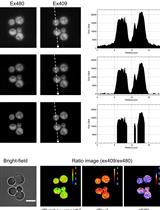
QUEEN-based Spatiotemporal ATP Imaging in Budding and Fission Yeast
Masak Takaine
Aug 5, 2019 7043 Views
Analysis of Protein Stability by Synthesis Shutoff
Ira Buntenbroich [...] Mafalda Escobar-Henriques
Nov 20, 2021 4020 Views
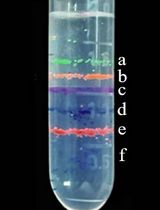
A Miniaturized Percoll Gradient Method for Isolation of Quiescent Cells of Yeast
Cenxuan Zu [...] Shaolan Zou
Apr 20, 2025 1455 Views
Abstract
Fusarium crown rot (FCR), mainly caused by Fusarium pseudograminearum, is a devastating soil-borne disease of wheat that results in severe yield and quality reduction. FCR is characterized by stem base necrosis and whitehead development. In recent years, FCR has escalated in both incidence and severity, emerging as a critical threat to global wheat production, particularly within key cultivation zones such as China's Huang-Huai-Hai Plain. The development of resistant cultivars is an effective and environmentally sustainable strategy for FCR disease control. However, the lack of standardized and reproducible inoculation protocols has hindered the accurate assessment and screening of disease-resistant wheat germplasms. To address this limitation, we established a robust FCR inoculation system utilizing F. pseudograminearum propagated on a millet grain substrate, facilitating rapid and reliable evaluation of both host resistance and fungal pathogenicity. Laboratory validation demonstrated high infection efficiency and strong reproducibility of this method.
Key features
• Standardized and reproducible greenhouse inoculation protocol for Fusarium crown rot resistance assessment, established in wheat.
• This system enables accurate quantification of F. pseudograminearum pathogenicity and facilitates high-throughput screening of resistant wheat germplasm.
Keywords: Fusarium pseudograminearumBackground
Fusarium crown rot (FCR) is a soil-borne disease caused by multiple Fusarium species, including F. pseudograminearum, F. graminearum, and F. culmorum [1]. Among these, F. pseudograminearum is the predominant causal agent in the Huang-Huai-Hai wheat region of China, a critical area for national wheat production [2]. FCR can infect wheat throughout its entire growth cycle. At the seedling stage, typical symptoms include browning of the leaf sheaths and stem bases, with severe infections leading to chlorosis and seedling death [3]. As plants advance to jointing and heading stages, stem base necrosis intensifies, often accompanied by pink mycelial growth at nodes under high humidity [4]. By maturity, severely infected plants exhibit premature senescence, whiteheads, and grain defects such as shriveled kernels or sterility, collectively leading to significant reductions in both yield and grain quality [5–6].
Currently, breeding resistant cultivars remains the cornerstone for effective management of FCR [7]. Chemical control strategies are constrained by the emergence of fungicide resistance and concerns over environmental contamination, which are also inconsistent with China’s Dual Reduction policy aimed at reducing pesticide and fertilizer use [8]. In this context, biological control has emerged as a promising alternative due to its sustainability and compatibility with ecological agriculture practices [9].
A major bottleneck in FCR research is the lack of reliable phenotyping tools. The terrace method can detect adult plant resistance, but it does not distinguish the very high level of susceptibility observed in durums in the field [8]. In current greenhouse resistance screening methods, glasshouse seedling bioassay is a good predictor of crown rot resistance in adult plants under field conditions, but crown rot severity is assessed 35 days after inoculation [10]. To overcome these limitations, we developed a standardized greenhouse inoculation protocol for FCR by optimizing pathogen preparation and the inoculation method. This system enables accurate quantification of F. pseudograminearum pathogenicity and high-throughput screening of resistant wheat germplasm under controlled environmental conditions.
Materials and reagents
1. Fusarium pseudograminearum strain Fp22-2 (provided by Huiquan Liu lab, College of Plant Protection, Northwest A&F University, Shaanxi, China) [11]
2. Wheat seeds (Triticum aestivum cv. Fielder, Huiquan Liu lab in College of Plant Protection, Northwest A&F University, Shaanxi province, China)
3. Wheat seeds (Xinong 529, Wanquan Ji lab, College of Agronomy, Northwest A&F University, Shaanxi province, China)
4. Millet grains (Beijing Heyatang Food Co., Ltd, catalog number: Gaia Farm 10013579379)
5. Substrate (Pindstrup Mosebrug A/S, Denmark, catalog number: 14013529)
6. Deionized water
7. Potato dextrose agar (PDA) medium (Beijing Aoboxing Bio-tech Company, Aobox®, catalog number: 02-023)
8. Ethanol (Tianjin Fuyu Fine Chemical Co., Ltd, AR 500 mL)
9. Sodium hypochlorite (Shanghai Macklin Biochemical Co., Ltd, catalog number: S828471-500mL)
10. 35 mm Petri dishes (Changde Bickman Biotechnology Co., Ltd, catalog number: B-SLPYM35)
11. 90 mm Petri dishes (Changde Bickman Biotechnology Co., Ltd, catalog number: B-SLPYM90)
12. Conical flasks, 250 mL (Haimen Ruibo Experimental Equipment Company, catalog number: RBSLZXP-250)
13. Black plastic pots (8 cm height × 7 cm diameter)
14. Toothpicks (Yekee, catalog number: Y-9892)
15. Filter paper (Shuangquan, catalog number: 99-202-090)
16. Tweezers (Haimen Chuangxin Experimental Equipment Company, catalog number: CX184-13)
Equipment
1. Automatic autoclave (Sanyo, model: MLS-3780)
2. Analytical balance (Shimadzu Tianping, Japan, model: AUX220)
3. Programmable growth chamber (controlling temperature and humidity) (Percival, model: E-36HO)
4. Digital camera (Nikon, model: D3000)
5. Calibrated ruler (Shanghai M&G Stationery INC, model: ARL96004)
Software and datasets
1. GraphPad Prism 10.0.3 software
Procedure
A. Millet grain substrate preparation
Boil millet grains (200 g) in 800 mL of deionized water for 3 min and then drain them. Autoclave the grains at 121 °C (15 psi) for 20 min and subsequently air-dry for 24 h before use.
B. Fungal preparation
1. Inoculate F. pseudograminearum strain Fp22-2 on PDA plates (d = 35 mm) and incubate in the dark at 25 °C for 3 days.
2. Transfer a quarter square centimeter (0.25 cm2) of fungal plug using sterilized toothpicks from the PDA plate to 250 mL conical flasks containing 100 g of sterilized millet grains on a sterile bench. Incubate the flasks at 25 °C for 7 days, hand-shaking twice daily to ensure even colonization of Fp22-2 in millet grains.
C. Wheat seed preparation
1. Surface-sterilize wheat seeds of variety Fielder through sequential immersion in 75% (v/v) ethanol for 1 min, followed by 1% sodium hypochlorite for 3 min. Then, rinse three times with sterile distilled water. Dry surface-sterilized seeds on sterile filter paper and germinate on moistened filter paper in 9 cm Petri dishes at 25 °C in the dark for 24 h. Select seeds exhibiting uniform radicles (1–2 mm length) for planting.
2. Inoculation on wheat seedlings:
a. Fill black plastic pots (8 cm in height × 7 cm in diameter) to three-quarters capacity with autoclaved substrate (121 °C, 30 min). Moisten each pot with 50 mL of sterile distilled water to achieve uniform substrate moisture.
b. Distribute colonized millet substrate (0.5 g) evenly over the substrate surface using tweezers. Arrange 16 germinated seeds on the inoculated substrate with a spacing of 15 mm and cover with a 15-mm layer of sterile substrate (Figure 1). Each treatment consists of three biological replicates arranged in a randomized complete block design.

Figure 1. Pre-germinated seeds planting. A: Colonized millet substrate; B: pre-germinated seeds.
c. Maintain pots in a climate-controlled growth chamber under a photoperiod of 18 h light (25 °C)/6 h dark (18 °C), with humidity maintained at 40%–60% for 14 days. Only on the fifth day, irrigate each pot with 10 mL of sterile distilled water. From day 6 to day 14, withhold irrigation to impose drought stress, a condition known to enhance the development of crown rot.
d. For each treatment, use three biological replicate pots. At 14 days post-inoculation, carefully uproot seedlings from the pots to avoid damage to the roots and stem base. Measure lesion lengths at the stem base using a plastic ruler. Assess disease severity according to the rating scale defined in Figure 2.
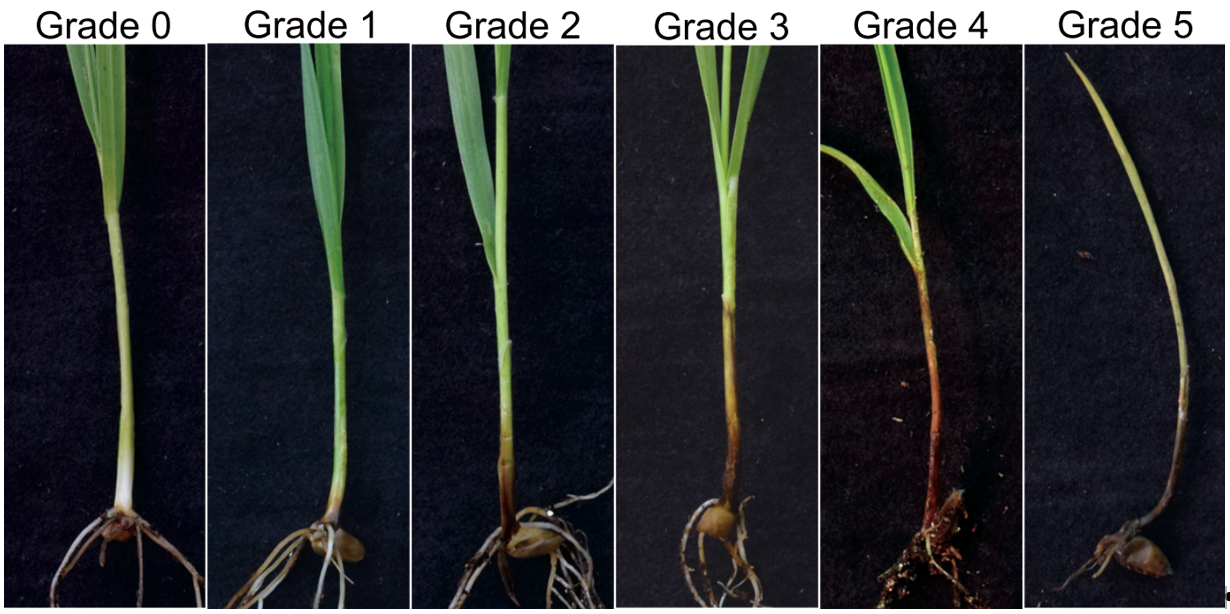
Figure 2. Disease severity level of Fusarium crown rot. Grade 0: No lesion (0 cm). Grade 1: Lesion length > 0 cm and ≤ 1 cm. Grade 2: Lesion length > 1 cm and ≤ 2 cm. Grade 3: Lesion length > 2 cm and ≤ 3 cm. Grade 4: Lesion length > 3 cm and ≤ 4 cm. Grade 5: Lesion length > 4 cm or plant death.
D. Inoculation result
About 14 days post-inoculation, the growth status of wheat is displayed; wheat did not show yellowing of leaves or death of plants due to drought stress. The enlarged wheat base in pots illustrates FCR occurrence (Figure 3A). The disease index of XN 529 is significantly lower than that of Fielder (Figure 3B).
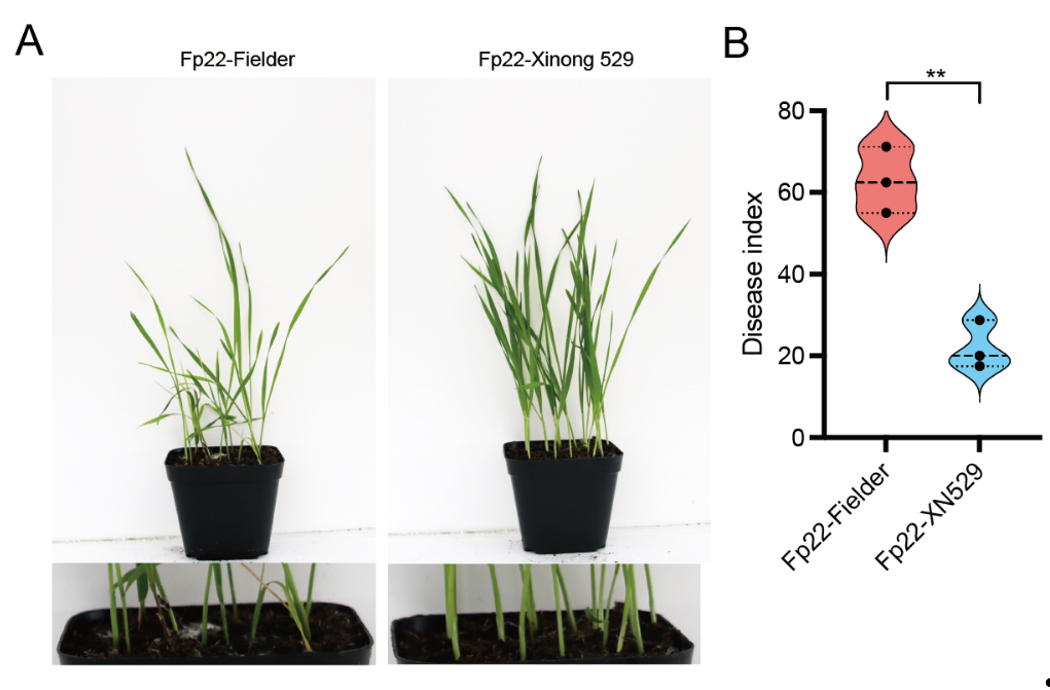
Figure 3. Disease response of wheat varieties with varying resistance to F. pseudograminearum. (A) Disease symptoms between wheat varieties Fielder and Xinong 529 (XN529). (B) Box plots comparing the disease index of Fielder and Xinong 529 (XN529). Significant difference was determined by Student’s t-test. ** p < 0.01.
Data analysis
The disease grade of each wheat plant (16 wheat plants in each pot) was determined according to Figure 2. The disease index of 3–5 pots (at least three) as a set of biological replicates was calculated using the following formula: Disease index (DI) = Σ (number of plants at each disease grade × representative value for that grade) / (maximum disease grade value × total number of plants surveyed) × 100%.
Upon inoculation with F. pseudograminearum strain Fp22, the susceptible wheat cultivar Fielder developed severe crown rot symptoms with a mean disease index of 62.92 ± 8.13. In contrast, the resistant cultivar XN529 exhibited significantly lower susceptibility, showing a mean disease index of 22.08 ± 5.91. Disease indices from different treatments were compared using bar charts or box plots. Statistical analyses were performed using GraphPad Prism version 10.0.3 (Figure 3B), and differences between groups were assessed using Student’s t-test with a significance threshold set at P < 0.05. The statistical result suggests that the FCR resistance of XN529 is significantly higher than that of Fielder.
Validation of protocol
To validate this protocol, we conducted disease resistance evaluation on different wheat cultivars. Chen et al. [12] found that, compared to tall wheat, dwarf wheat has a higher plant cell density and milder symptoms of disease. Zhang et al. [13] found that the FCR incidence rate of wheat varieties with strong cold resistance is also low. In terms of these traits, XN529 outperforms Fielder. The XN529 variety demonstrated significant disease resistance, while the Fielder exhibited susceptibility (Figure 3). This evidence indicates that the inoculation method is suitable for assessing disease resistance in wheat cultivars. In addition, we used this method to successfully identify the biocontrol agent Clonostachys chloroleuca Cc620, which can prevent and control FCR, and applied for a patent [14].
General notes and troubleshooting
1. Pre-soaking of millet grains is not required. After boiling, excess water must be thoroughly drained, as excessive moisture can compromise the colonization process and lead to experimental failure.
2. The flasks should be manually shaken to evenly disperse the millet grains and ensure sufficient contact with the fungal inoculum. The surface of the millet grains is uniformly covered with white mycelium, and millet grains turn red, indicating successful colonization of F. pseudograminearum (Figure 4). The absence of grain clumping confirms effective sterilization and adequate drying of the substrate.
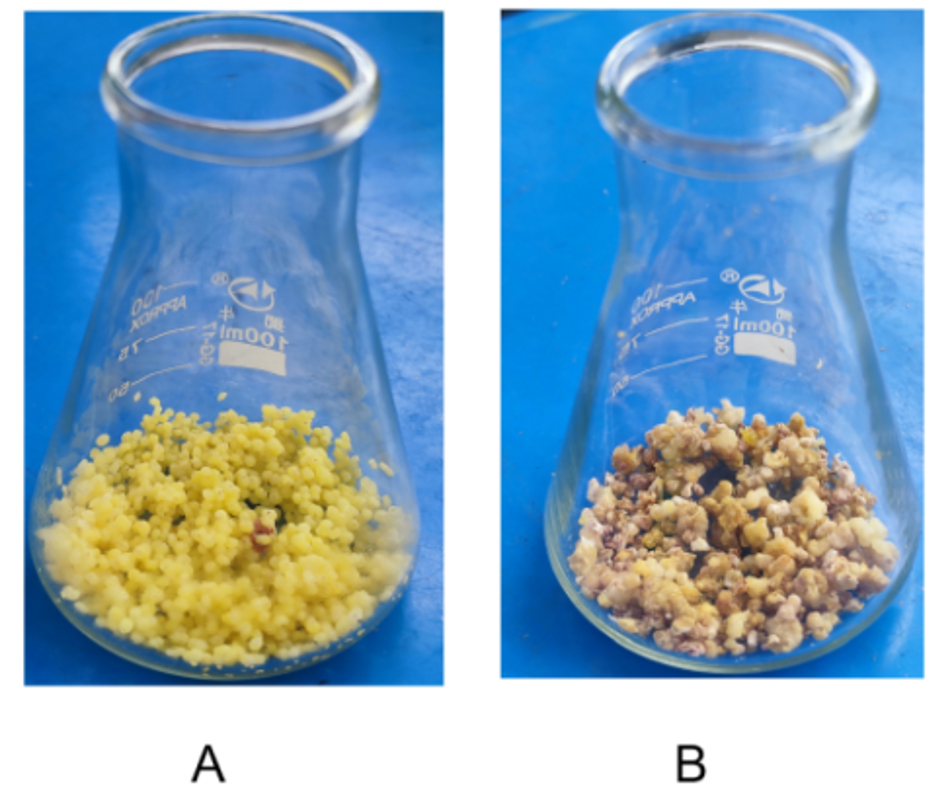
Figure 4. Millet grains before and after colonization. (A) Mixture of millet grains and F. pseudograminearum strain Fp22-2 on day 1. (B) Mixture of millet grains and F. pseudograminearum strain Fp22-2 on day 7.
Acknowledgments
This protocol was described by Xu et al (Unpublished). This work was supported by the Chinese Universities Scientific Fund (2452023045). Z.T. and W.R.K. performed the experiments and prepared the manuscript draft. M.X. and X.Z. reviewed and edited the manuscript.
Competing interests
The authors declare no competing interests.
References
- Ma, G., Wang, H., Qi, K., Ma, L., Zhang, B., Zhang, Y., Jiang, H., Wu, X. and Qi, J. (2024). Isolation, characterization, and pathogenicity of Fusarium species causing crown rot of wheat. Front Microbiol. 15: e1405115. https://doi.org/10.3389/fmicb.2024.1405115
- Li, H. L., Yuan, H. X., Fu, B., Xing, X. P., Sun, B. J. and Tang, W. H. (2012). First Report of Fusarium pseudograminearum Causing Crown Rot of Wheat in Henan, China. Plant Dis. 96(7): 1065–1065. https://doi.org/10.1094/pdis-01-12-0007-pdn
- Kettle, A. J., Carere, J., Batley, J., Benfield, A. H., Manners, J. M., Kazan, K. and Gardiner, D. M. (2015). A γ-lactamase from cereal infecting Fusarium spp. catalyses the first step in the degradation of the benzoxazolinone class of phytoalexins. Fungal Genetics and Biology 83: 1–9. https://doi.org/10.1016/j.fgb.2015.08.005
- Obanor, F., Neate, S., Simpfendorfer, S., Sabburg, R., Wilson, P. and Chakraborty, S. (2012). Fusarium graminearum and Fusarium pseudograminearum caused the 2010 head blight epidemics in Australia. Plant Pathol. 62(1): 79–91. https://doi.org/10.1111/j.1365-3059.2012.02615.x
- Sperschneider, J., Dodds, P. N., Gardiner, D. M., Singh, K. B. and Taylor, J. M. (2018). Improved prediction of fungal effector proteins from secretomes with EffectorP 2.0. Mol Plant Pathol. 19(9): 2094–2110. https://doi.org/10.1111/mpp.12682
- Gorash, A., Armonienė, R. and Kazan, K. (2021). Can effectoromics and loss-of-susceptibility be exploited for improving Fusarium head blight resistance in wheat?. The Crop Journal. 9(1): 1–16. https://doi.org/10.1016/j.cj.2020.06.012
- Wang, C., Sun, M., Zhang, P., Ren, X., Zhao, S., Li, M., Ren, Z., Yuan, M., Ma, L., Liu, Z., et al. (2024). Genome-Wide Association Studies on Chinese Wheat Cultivars Reveal a Novel Fusarium Crown Rot Resistance Quantitative Trait Locus on Chromosome 3BL. Plants 13(6): 856. https://doi.org/10.3390/plants13060856
- Wallwork, H., Butt, M., Cheong, J. P. E. and Williams, K. J. (2004). Resistance to crown rot in wheat identified through an improved method for screening adult plants. Australas Plant Pathol. 33(1): 1. https://doi.org/10.1071/ap03073
- Kamil, F. H., Saeed, E. E., El-Tarabily, K. A. and AbuQamar, S. F. (2018). Biological Control of Mango Dieback Disease Caused by Lasiodiplodia theobromae Using Streptomycete and Non-streptomycete Actinobacteria in the United Arab Emirates. Front Microbiol. 9: e00829. https://doi.org/10.3389/fmicb.2018.00829
- Mitter, V., Zhang, M. C., Liu, C. J., Ghosh, R., Ghosh, M. and Chakraborty, S. (2006). A high‐throughput glasshouse bioassay to detect crown rot resistance in wheat germplasm. Plant Pathol. 55(3): 433–441. https://doi.org/10.1111/j.1365-3059.2006.01384.x
- Tai, J., Zhang, X., Gao, X., Liu, H. and Xu, M. (2023). High-Quality Genome Resource of Fusarium pseudograminearum Isolate Fp22-2 by Oxford Nanopore Long-Read Sequencing. Plant Dis. 107(6): 1925–1928. https://doi.org/10.1094/pdis-09-22-2034-a
- Chen, G., Yan, W., Liu, Y., Wei, Y., Zhou, M., Zheng, Y. L., Manners, J. M. and Liu, C. (2014). The non-gibberellic acid-responsive semi-dwarfing gene uzu affects Fusarium crown rot resistance in barley. BMC Plant Biol. 14(1): e1186/1471–2229–14–22. https://doi.org/10.1186/1471-2229-14-22
- Zhang, S., Song, G., Gao, J., Li, Y., Zhang, R., Li, W., Wang, J., Chen, M., Han, X., & Li, G.. (2017). Research advances on cold resistance of wheat (Triticum aestivum L.) in spring. Shandong Agricultural Sciences. 49(6):161. https://doi.org/10.14083/j.issn.1001-4942.2017.06.033.
- Liu, H.; Zhang, X.; et al. Application of Clonostachys chloroleuca in the prevention and control of wheat soil borne diseases. Authorization announcement No.: CN117925421B, Date (6 18, 2024).
Article Information
Publication history
Received: Jun 13, 2025
Accepted: Aug 7, 2025
Available online: Aug 13, 2025
Published: Sep 20, 2025
Copyright
© 2025 The Author(s); This is an open access article under the CC BY-NC license (https://creativecommons.org/licenses/by-nc/4.0/).
How to cite
Tang, Z., Kong, W., Xu, M. and Zhang, X. (2025). A Method to Inoculate Millet Grain-Colonized Fusarium pseudograminearum on Wheat to Obtain Reproducible Disease Symptoms. Bio-protocol 15(18): e5438. DOI: 10.21769/BioProtoc.5438.
Category
Plant Science > Plant immunity > Disease symptom
Microbiology > in vivo model > Fungi
Do you have any questions about this protocol?
Post your question to gather feedback from the community. We will also invite the authors of this article to respond.
Share
Bluesky
X
Copy link







